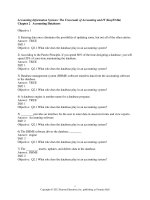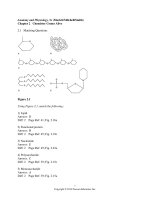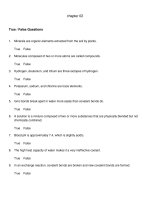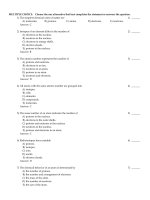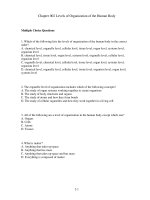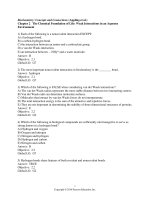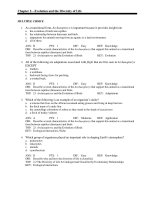Anatomy and physiology 1st edition mckinley test bank
Bạn đang xem bản rút gọn của tài liệu. Xem và tải ngay bản đầy đủ của tài liệu tại đây (370.68 KB, 67 trang )
Chapter 02 - Atoms, Ions, and Molecules
Chapter 02
Atoms, Ions, and Molecules
Fill in the Blank Questions
1. Anything that has mass and occupies space is considered to be ________.
matter
Bloom's Level: 1. Remember
HAPS Objective: C01.01a With respect to the structure of an atom: Describe the charge,
mass, and relative location of electrons, protons and neutrons.
HAPS Topic: Module C01 Atoms & molecules.
Learning Objective: 02.01.01 Define matter, and list its three forms.
Section: 02.01a
Topic: Chemistry
Multiple Choice Questions
2. The three forms of matter are:
A. air, water, and solids.
B. solids, liquids, and gases.
C. blood, bone, and air.
D. vapor, water, and solid.
Bloom's Level: 1. Remember
HAPS Objective: C01.01a With respect to the structure of an atom: Describe the charge,
mass, and relative location of electrons, protons and neutrons.
HAPS Topic: Module C01 Atoms & molecules.
Learning Objective: 02.01.01 Define matter, and list its three forms.
Section: 02.01a
Topic: Chemistry
2-
Chapter 02 - Atoms, Ions, and Molecules
3. Which of the following has the smallest mass?
A. An electron
B. An atomic nucleus
C. A proton
D. A neutron
Bloom's Level: 2. Understand
HAPS Objective: C01.01a With respect to the structure of an atom: Describe the charge,
mass, and relative location of electrons, protons and neutrons.
HAPS Topic: Module C01 Atoms & molecules.
Learning Objective: 02.01.02 Describe and differentiate among the subatomic particles that
compose atoms.
Section: 02.01a
Topic: Chemistry
True / False Questions
4. An atomic nucleus consists of protons and neutrons and is positively charged.
TRUE
Bloom's Level: 1. Remember
HAPS Objective: C01.01a With respect to the structure of an atom: Describe the charge,
mass, and relative location of electrons, protons and neutrons.
HAPS Topic: Module C01 Atoms & molecules.
Learning Objective: 02.01.02 Describe and differentiate among the subatomic particles that
compose atoms.
Section: 02.01a
Topic: Chemistry
2-
Chapter 02 - Atoms, Ions, and Molecules
Multiple Choice Questions
5. Which of the following statements accurately describes electrons?
A. They are found inside the nucleus and have a positive charge.
B. They are in orbitals outside the nucleus and have a positive charge.
C. They are found inside the nucleus and have a negative charge.
D. They are in orbitals outside the nucleus and have a negative charge.
Bloom's Level: 1. Remember
HAPS Objective: C01.01a With respect to the structure of an atom: Describe the charge,
mass, and relative location of electrons, protons and neutrons.
HAPS Topic: Module C01 Atoms & molecules.
Learning Objective: 02.01.02 Describe and differentiate among the subatomic particles that
compose atoms.
Section: 02.01a
Topic: Chemistry
6. An element's atomic number is determined by the number of __________ in one atom of
that element.
A. protons
B. nuclei
C. electrons
D. neutrons
E. atomic mass units
Bloom's Level: 1. Remember
HAPS Objective: C01.01d With respect to the structure of an atom: Distinguish among the
terms atomic number, mass number and atomic weight.
HAPS Topic: Module C01 Atoms & molecules.
Learning Objective: 02.01.03 Explain the arrangement of elements in the periodic table based
on atomic number.
Section: 02.01a
Topic: Chemistry
2-
Chapter 02 - Atoms, Ions, and Molecules
7. Within the periodic table, elements are organized consecutively by:
A. atomic mass within columns.
B. atomic mass within rows.
C. atomic number within columns.
D. atomic number within rows.
Bloom's Level: 1. Remember
HAPS Objective: C01.01d With respect to the structure of an atom: Distinguish among the
terms atomic number, mass number and atomic weight.
HAPS Topic: Module C01 Atoms & molecules.
Learning Objective: 02.01.03 Explain the arrangement of elements in the periodic table based
on atomic number.
Section: 02.01a
Topic: Chemistry
8. The number of neutrons in an atom can be determined by:
A. subtracting the atomic number from the atomic mass.
B. subtracting the atomic mass from the atomic number.
C. adding the atomic mass to the atomic number.
D. adding the number of protons to the number of electrons.
E. adding the number of protons to the atomic number.
Bloom's Level: 2. Understand
HAPS Objective: C01.01d With respect to the structure of an atom: Distinguish among the
terms atomic number, mass number and atomic weight.
HAPS Topic: Module C01 Atoms & molecules.
Learning Objective: 02.01.03 Explain the arrangement of elements in the periodic table based
on atomic number.
Section: 02.01a
Topic: Chemistry
2-
Chapter 02 - Atoms, Ions, and Molecules
9. When diagramming an atom, the innermost shell is filled with ______ electrons.
A. two
B. six
C. eight
D. ten
Bloom's Level: 1. Remember
HAPS Objective: C01.01b With respect to the structure of an atom: Relate the number of
electrons in an electron shell to an atom’s chemical stability and its ability to form chemical
bonds.
HAPS Topic: Module C01 Atoms & molecules.
Learning Objective: 02.01.04 Diagram the structure of an atom.
Section: 02.01a
Topic: Chemistry
Short Answer Questions
10. Explain how the structure of an oxygen atom with an atomic mass of sixteen would be
diagrammed. Include the number of subatomic particles in each part of the atom.
The nucleus would consist of eight protons and eight neutrons. There would be two electron
shells; the innermost would contain two electrons and the outer one would hold six.
Bloom's Level: 3. Apply
HAPS Objective: C01.01a With respect to the structure of an atom: Describe the charge,
mass, and relative location of electrons, protons and neutrons.
HAPS Topic: Module C01 Atoms & molecules.
Learning Objective: 02.01.04 Diagram the structure of an atom.
Section: 02.01a
Topic: Chemistry
2-
Chapter 02 - Atoms, Ions, and Molecules
Multiple Choice Questions
11. When diagramming an atom, how many electrons can fit in each of the shells beyond the
innermost shell?
A. Two
B. Six
C. Eight
D. Ten
Bloom's Level: 1. Remember
HAPS Objective: C01.01b With respect to the structure of an atom: Relate the number of
electrons in an electron shell to an atom’s chemical stability and its ability to form chemical
bonds.
HAPS Topic: Module C01 Atoms & molecules.
Learning Objective: 02.01.04 Diagram the structure of an atom.
Section: 02.01a
Topic: Chemistry
12. Two atoms that differ only in the number of neutrons they contain are known as:
A. anions.
B. isomers.
C. isotopes.
D. ions.
Bloom's Level: 1. Remember
HAPS Objective: C01.01c With respect to the structure of an atom: Explain how ions and
isotopes are produced by changing the relative number of specific subatomic particles.
HAPS Topic: Module C01 Atoms & molecules.
Learning Objective: 02.01.05 Describe an isotope.
Section: 02.01b
Topic: Chemistry
2-
Chapter 02 - Atoms, Ions, and Molecules
True / False Questions
13. All isotopes of a given element have the same atomic mass.
FALSE
Bloom's Level: 1. Remember
HAPS Objective: C01.01c With respect to the structure of an atom: Explain how ions and
isotopes are produced by changing the relative number of specific subatomic particles.
HAPS Topic: Module C01 Atoms & molecules.
Learning Objective: 02.01.05 Describe an isotope.
Section: 02.01b
Topic: Chemistry
Fill in the Blank Questions
14. Two atoms that have the same chemical characteristics but different atomic masses are
considered __________.
isotopes or
isotope
Bloom's Level: 1. Remember
HAPS Objective: C01.01c With respect to the structure of an atom: Explain how ions and
isotopes are produced by changing the relative number of specific subatomic particles.
HAPS Topic: Module C01 Atoms & molecules.
Learning Objective: 02.01.05 Describe an isotope.
Section: 02.01b
Topic: Chemistry
2-
Chapter 02 - Atoms, Ions, and Molecules
Multiple Choice Questions
15. Radioisotopes contain:
A. an insufficient number of neutrons.
B. an insufficient number of electrons.
C. an insufficient number of protons.
D. an excess of protons.
E. an excess of neutrons.
Bloom's Level: 1. Remember
HAPS Objective: C01.02 Compare and contrast the terms ions, electrolytes, free radicals,
isotopes and radioisotopes.
HAPS Topic: Module C01 Atoms & molecules.
Learning Objective: 02.01.06 Explain how radioisotopes differ from other types of isotopes.
Section: 02.01b
Topic: Chemistry
True / False Questions
16. The half life of a radioisotope is at least one day and at most ten years.
FALSE
Bloom's Level: 3. Apply
HAPS Objective: C01.02 Compare and contrast the terms ions, electrolytes, free radicals,
isotopes and radioisotopes.
HAPS Topic: Module C01 Atoms & molecules.
Learning Objective: 02.01.06 Explain how radioisotopes differ from other types of isotopes.
Section: 02.01b
Topic: Chemistry
2-
Chapter 02 - Atoms, Ions, and Molecules
Multiple Choice Questions
17. Biological half life is the time required for:
A. half of an ionic compound to ionize.
B. half of a radioactive material to be eliminated from the body.
C. radioactivity levels of organic compounds to stabilize at one half their original value.
D. radiation exposure that is lethal for half of a biological population.
Bloom's Level: 1. Remember
HAPS Objective: C01.02 Compare and contrast the terms ions, electrolytes, free radicals,
isotopes and radioisotopes.
HAPS Topic: Module C01 Atoms & molecules.
Learning Objective: 02.01.06 Explain how radioisotopes differ from other types of isotopes.
Section: 02.01b
Topic: Chemistry
Fill in the Blank Questions
18. Another name for the outer electron shell of an atom is the ________ shell.
valence
Bloom's Level: 1. Remember
HAPS Objective: C01.01b With respect to the structure of an atom: Relate the number of
electrons in an electron shell to an atom’s chemical stability and its ability to form chemical
bonds.
HAPS Topic: Module C01 Atoms & molecules.
Learning Objective: 02.01.07 Describe how elements are organized in the periodic table
based on the valence electron number.
Section: 02.01c
Topic: Chemistry
2-
Chapter 02 - Atoms, Ions, and Molecules
Multiple Choice Questions
19. On the periodic table, beryllium sits above magnesium and to the right of lithium. Given
that magnesium has two electrons in its outer shell and lithium has one, how many electrons
would you predict beryllium has in its outer shell?
A. One
B. Two
C. Three
D. Four
Bloom's Level: 3. Apply
HAPS Objective: C01.01d With respect to the structure of an atom: Distinguish among the
terms atomic number, mass number and atomic weight.
HAPS Topic: Module C01 Atoms & molecules.
Learning Objective: 02.01.07 Describe how elements are organized in the periodic table
based on the valence electron number.
Section: 02.01c
Topic: Chemistry
Fill in the Blank Questions
20. In general, the number of electrons that would fill an atom's outer shell and make it
nonreactive is _______.
eight or
8 or
octet
Bloom's Level: 1. Remember
HAPS Objective: C01.01b With respect to the structure of an atom: Relate the number of
electrons in an electron shell to an atom’s chemical stability and its ability to form chemical
bonds.
HAPS Topic: Module C01 Atoms & molecules.
Learning Objective: 02.01.08 State the octet rule.
Section: 02.01c
Topic: Chemistry
2-
Chapter 02 - Atoms, Ions, and Molecules
True / False Questions
21. Elements in the first column of the periodic table contain one electron in their outer shell.
TRUE
Bloom's Level: 1. Remember
HAPS Objective: C01.01b With respect to the structure of an atom: Relate the number of
electrons in an electron shell to an atom’s chemical stability and its ability to form chemical
bonds.
HAPS Topic: Module C01 Atoms & molecules.
Learning Objective: 02.01.07 Describe how elements are organized in the periodic table
based on the valence electron number.
Section: 02.01c
Topic: Chemistry
Fill in the Blank Questions
22. An atom with a positive or negative charge is known as a(n) ________.
ion
Bloom's Level: 1. Remember
HAPS Objective: C01.02 Compare and contrast the terms ions, electrolytes, free radicals,
isotopes and radioisotopes.
HAPS Topic: Module C01 Atoms & molecules.
Learning Objective: 02.02.01 Define an ion.
Section: 02.02a
Topic: Chemistry
2-
Chapter 02 - Atoms, Ions, and Molecules
Multiple Choice Questions
23. An ion is an atom or group of atoms that has:
A. a different number of neutrons than most atoms of that element.
B. lost or gained a proton.
C. lost or gained an electron.
D. a biological half life due to radioactive decay.
Bloom's Level: 1. Remember
HAPS Objective: C01.01c With respect to the structure of an atom: Explain how ions and
isotopes are produced by changing the relative number of specific subatomic particles.
HAPS Topic: Module C01 Atoms & molecules.
Learning Objective: 02.02.01 Define an ion.
Section: 02.02a
Topic: Chemistry
Fill in the Blank Questions
24. The most common extracellular cation is ________.
sodium or
Na or
Na+
Bloom's Level: 1. Remember
HAPS Objective: C03.03 Define the term salt and give examples of physiological
significance.
HAPS Topic: Module C03 Inorganic compounds & solutions.
Learning Objective: 02.02.02 List some common ions in the body.
Section: 02.02a
Topic: Chemistry
2-
Chapter 02 - Atoms, Ions, and Molecules
True / False Questions
25. Positively charged ions are called cations.
TRUE
Bloom's Level: 1. Remember
HAPS Objective: C01.01c With respect to the structure of an atom: Explain how ions and
isotopes are produced by changing the relative number of specific subatomic particles.
HAPS Topic: Module C01 Atoms & molecules.
Learning Objective: 02.02.03 Differentiate between cations and anions.
Section: 02.02a
Topic: Chemistry
Multiple Choice Questions
26. The molecular formula for bicarbonate ion is HCO3-. It is therefore a:
A. polyatomic anion.
B. polyatomic cation.
C. radioactive isotope.
D. cationic compound.
Bloom's Level: 3. Apply
HAPS Objective: C01.03 Compare and contrast the terms atoms, molecules, elements, and
compounds.
HAPS Topic: Module C01 Atoms & molecules.
Learning Objective: 02.02.03 Differentiate between cations and anions.
Section: 02.02a
Topic: Chemistry
2-
Chapter 02 - Atoms, Ions, and Molecules
Essay Questions
27. Describe the ionic form of calcium (what is its charge)? Then describe how three
physiological systems would malfunction if calcium levels were not maintained
homeostatically.
Calcium is a divalent cation. If calcium levels are abnormal: 1) bones may weaken, 2)
excitable tissues malfunction (e.g., skeletal and cardiac muscle contractions are impaired), and
3) blood clotting might be inadequate.
Bloom's Level: 3. Apply
HAPS Objective: C03.03 Define the term salt and give examples of physiological
significance.
HAPS Topic: Module C03 Inorganic compounds & solutions.
Learning Objective: 02.02.02 List some common ions in the body.
Section: 02.02a
Topic: Chemistry
Multiple Choice Questions
28. When atoms of elements on the left side of the periodic table ionize, they tend to:
A. gain electrons and therefore become anions.
B. gain protons and therefore become anions.
C. lose electrons and therefore become cations.
D. lose protons and therefore become cations.
E. add neutrons and therefore become megaions.
Bloom's Level: 3. Apply
HAPS Objective: C01.01c With respect to the structure of an atom: Explain how ions and
isotopes are produced by changing the relative number of specific subatomic particles.
HAPS Topic: Module C01 Atoms & molecules.
Learning Objective: 02.02.04 Describe how charges are assigned to ions.
Section: 02.02a
Topic: Chemistry
2-
Chapter 02 - Atoms, Ions, and Molecules
29. When elements found in column VIA of the periodic table become ions, they usually
have a charge of:
A. –2.
B. –1.
C. +1.
D. +2.
E. +3.
Bloom's Level: 2. Understand
HAPS Objective: C01.01c With respect to the structure of an atom: Explain how ions and
isotopes are produced by changing the relative number of specific subatomic particles.
HAPS Topic: Module C01 Atoms & molecules.
Learning Objective: 02.02.04 Describe how charges are assigned to ions.
Section: 02.02a
Topic: Chemistry
True / False Questions
30. Phosphate ions are common cations within the body.
FALSE
Bloom's Level: 1. Remember
HAPS Objective: C03.03 Define the term salt and give examples of physiological
significance.
HAPS Topic: Module C03 Inorganic compounds & solutions.
Learning Objective: 02.02.02 List some common ions in the body.
Section: 02.02a
Topic: Chemistry
2-
Chapter 02 - Atoms, Ions, and Molecules
Multiple Choice Questions
31. If an ionic compound formed between an element from the first column of the periodic
table and another from the sixth column, you would expect the compound to include:
A. one atom from each of the two elements.
B. one atom from the first column element and two atoms from the sixth column element.
C. two atoms from the first column element and one atom from the sixth column element.
D. three atoms from the first column element and two from the sixth column element.
Bloom's Level: 5. Evaluate
HAPS Objective: C01.01b With respect to the structure of an atom: Relate the number of
electrons in an electron shell to an atom’s chemical stability and its ability to form chemical
bonds.
HAPS Topic: Module C01 Atoms & molecules.
Learning Objective: 02.02.05 Define an ionic bond.
Section: 02.02b
Topic: Chemistry
32. Ionic bonds involve:
A. electrostatic interactions between anions and cations.
B. the sharing of electrons between two atoms of the same element.
C. the attraction between water and salts.
D. the release of protons by negatively charged particles.
Bloom's Level: 2. Understand
HAPS Objective: C02.01b With respect to non-polar covalent, polar covalent, ionic, and
hydrogen bonds: Explain the mechanism of each type of bond.
HAPS Topic: Module C02 Chemical bonding.
Learning Objective: 02.02.05 Define an ionic bond.
Section: 02.02b
Topic: Chemistry
2-
Chapter 02 - Atoms, Ions, and Molecules
33. In the formation of a compound of sodium chloride:
A. a chlorine atom donates an electron to a sodium atom.
B. a chloride ion donates two protons to a sodium ion.
C. a sodium atom donates an electron to a chlorine atom.
D. a sodium ion donates two electrons to a chlorine atom.
E. the sodium and chlorine atoms share a pair of electrons equally.
Bloom's Level: 1. Remember
HAPS Objective: C02.01b With respect to non-polar covalent, polar covalent, ionic, and
hydrogen bonds: Explain the mechanism of each type of bond.
HAPS Topic: Module C02 Chemical bonding.
Learning Objective: 02.02.06 Describe an ionic compound of NaCl.
Section: 02.02b
Topic: Chemistry
True / False Questions
34. Sodium bicarbonate (NaHCO3) is considered an ionic compound.
TRUE
Bloom's Level: 1. Remember
HAPS Objective: C02.01c With respect to non-polar covalent, polar covalent, ionic, and
hydrogen bonds: Provide biologically significant examples of each.
HAPS Topic: Module C02 Chemical bonding.
Learning Objective: 02.02.07 List other examples of ionic compounds.
Section: 02.02b
Topic: Chemistry
2-
Chapter 02 - Atoms, Ions, and Molecules
Multiple Choice Questions
35. Water contains two hydrogen atoms bound to one oxygen atom; "H2O" is therefore
water's:
A. molecular formula.
B. ionic compound.
C. isotope ratio.
D. stochastic isomer.
Bloom's Level: 3. Apply
HAPS Objective: C01.03 Compare and contrast the terms atoms, molecules, elements, and
compounds.
HAPS Topic: Module C01 Atoms & molecules.
Learning Objective: 02.03.01 Define a molecular formula.
Section: 02.03a
Topic: Chemistry
36. Which statement accurately describes isomers?
A. They possess differing numbers of neutrons in their nuclei.
B. They have the same molecular shape but involve different elements.
C. They have the same structural formula but different molecular formulas.
D. They have the same molecular formula but different structural formulas.
E. They have gained or lost electrons at their outer shell.
Bloom's Level: 2. Understand
HAPS Objective: C01.03 Compare and contrast the terms atoms, molecules, elements, and
compounds.
HAPS Topic: Module C01 Atoms & molecules.
Learning Objective: 02.03.02 Describe a structural formula, and explain its use in
differentiating isomers.
Section: 02.03a
Topic: Chemistry
2-
Chapter 02 - Atoms, Ions, and Molecules
Fill in the Blank Questions
37. The numbers and types of atoms in a molecule as well as the spatial arrangement of those
atoms is provided by the ________ formula.
structural
Bloom's Level: 1. Remember
HAPS Objective: C01.03 Compare and contrast the terms atoms, molecules, elements, and
compounds.
HAPS Topic: Module C01 Atoms & molecules.
Learning Objective: 02.03.02 Describe a structural formula, and explain its use in
differentiating isomers.
Section: 02.03a
Topic: Chemistry
True / False Questions
38. Isomers of the same molecule have identical chemical properties.
FALSE
Bloom's Level: 2. Understand
HAPS Objective: C01.03 Compare and contrast the terms atoms, molecules, elements, and
compounds.
HAPS Topic: Module C01 Atoms & molecules.
Learning Objective: 02.03.02 Describe a structural formula, and explain its use in
differentiating isomers.
Section: 02.03a
Topic: Chemistry
2-
Chapter 02 - Atoms, Ions, and Molecules
Multiple Choice Questions
39. What is the number of covalent bonds that at an atom of nitrogen can form within a
molecule?
A. 1
B. 2
C. 3
D. 4
Bloom's Level: 1. Remember
HAPS Objective: C02.01c With respect to non-polar covalent, polar covalent, ionic, and
hydrogen bonds: Provide biologically significant examples of each.
HAPS Topic: Module C02 Chemical bonding.
Learning Objective: 02.03.03 Describe a covalent bond and explain its formation based on
the octet rule.
Section: 02.03b
Topic: Chemistry
40. Which of the following is not one of the four most common elements in the body?
A. Oxygen
B. Nitrogen
C. Hydrogen
D. Carbon
E. Calcium
Bloom's Level: 1. Remember
HAPS Objective: C01.03 Compare and contrast the terms atoms, molecules, elements, and
compounds.
HAPS Topic: Module C01 Atoms & molecules.
Learning Objective: 02.03.04 List the four most common elements in the human body.
Section: 02.03b
Topic: Chemistry
2-
Chapter 02 - Atoms, Ions, and Molecules
41. A double covalent bond involves:
A. the sharing of one pair of electrons.
B. the sharing of two pairs of electrons.
C. the donation of one pair of electrons.
D. the donation of two pairs of electrons.
Bloom's Level: 1. Remember
HAPS Objective: C02.01b With respect to non-polar covalent, polar covalent, ionic, and
hydrogen bonds: Explain the mechanism of each type of bond.
HAPS Topic: Module C02 Chemical bonding.
Learning Objective: 02.03.05 Distinguish between single, double, and triple covalent bonds.
Section: 02.03b
Topic: Chemistry
42. Consider an atom with four electrons in its outer shell. If that atom is covalently bound to
three other atoms within a molecule, then it is:
A. in a double bond with one atom and in single bonds with two atoms.
B. in a single bond with one atom and in double bonds with two atoms.
C. in a triple bond with one atom and in single bonds with two atoms.
D. in double bonds with all three atoms.
E. in single bonds with all three atoms.
Bloom's Level: 3. Apply
HAPS Objective: C01.01b With respect to the structure of an atom: Relate the number of
electrons in an electron shell to an atom’s chemical stability and its ability to form chemical
bonds.
HAPS Topic: Module C01 Atoms & molecules.
Learning Objective: 02.03.05 Distinguish between single, double, and triple covalent bonds.
Section: 02.03b
Topic: Chemistry
2-
Chapter 02 - Atoms, Ions, and Molecules
True / False Questions
43. When two atoms with very different electronegativity share electrons a polar covalent
bond is formed.
TRUE
Bloom's Level: 2. Understand
HAPS Objective: C02.01b With respect to non-polar covalent, polar covalent, ionic, and
hydrogen bonds: Explain the mechanism of each type of bond.
HAPS Topic: Module C02 Chemical bonding.
Learning Objective: 02.03.06 Explain polar and nonpolar covalent bonds.
Section: 02.03b
Topic: Chemistry
Multiple Choice Questions
44. If an element from the first column of the periodic table entered into a covalent bond with
one from the sixth column, then the bond would be a:
A. polar bond, with the element from the first column developing a partial negative charge.
B. polar bond, with the element from the sixth column developing a partial negative charge.
C. nonpolar bond, with the element from the first column developing a partial positive
charge.
D. nonpolar bond, with the element from the sixth column developing a partial positive
charge.
E. nonpolar bond, with neither element developing any partial charges at all.
Bloom's Level: 3. Apply
HAPS Objective: C02.01b With respect to non-polar covalent, polar covalent, ionic, and
hydrogen bonds: Explain the mechanism of each type of bond.
HAPS Topic: Module C02 Chemical bonding.
Learning Objective: 02.03.06 Explain polar and nonpolar covalent bonds.
Section: 02.03b
Topic: Chemistry
2-
Chapter 02 - Atoms, Ions, and Molecules
True / False Questions
45. Oxygen is more electronegative than carbon.
TRUE
Bloom's Level: 1. Remember
HAPS Objective: C01.01b With respect to the structure of an atom: Relate the number of
electrons in an electron shell to an atom’s chemical stability and its ability to form chemical
bonds.
HAPS Topic: Module C01 Atoms & molecules.
Learning Objective: 02.03.06 Explain polar and nonpolar covalent bonds.
Section: 02.03b
Topic: Chemistry
46. Any molecule that contains a polar bond within it is a polar molecule.
FALSE
Bloom's Level: 2. Understand
HAPS Objective: C02.01b With respect to non-polar covalent, polar covalent, ionic, and
hydrogen bonds: Explain the mechanism of each type of bond.
HAPS Topic: Module C02 Chemical bonding.
Learning Objective: 02.03.07 Describe the difference between a nonpolar molecule and a
polar molecule.
Section: 02.03c
Topic: Chemistry
2-
Chapter 02 - Atoms, Ions, and Molecules
Multiple Choice Questions
47. Fatty acids consist mainly of carbon and hydrogen, and so fatty acids are:
A. nonpolar and do not dissolve in water.
B. nonpolar and dissolve in water.
C. polar and do not dissolve in water.
D. polar and dissolve in water.
Bloom's Level: 3. Apply
HAPS Objective: C02.01c With respect to non-polar covalent, polar covalent, ionic, and
hydrogen bonds: Provide biologically significant examples of each.
HAPS Topic: Module C02 Chemical bonding.
Learning Objective: 02.03.07 Describe the difference between a nonpolar molecule and a
polar molecule.
Section: 02.03c
Topic: Chemistry
48. Phospholipids are described as:
A. polar.
B. nonpolar.
C. amphipathic.
D. amphiprotic.
Bloom's Level: 1. Remember
HAPS Objective: C02.01c With respect to non-polar covalent, polar covalent, ionic, and
hydrogen bonds: Provide biologically significant examples of each.
HAPS Topic: Module C02 Chemical bonding.
Learning Objective: 02.03.08 Define an amphipathic molecule.
Section: 02.03c
Topic: Chemistry
2-
Chapter 02 - Atoms, Ions, and Molecules
49. An individual hydrogen bond in a sample of water would be described as:
A. strong and intramolecular.
B. strong and intermolecular.
C. weak and intramolecular.
D. weak and intermolecular.
Bloom's Level: 1. Remember
HAPS Objective: C02.01a With respect to non-polar covalent, polar covalent, ionic, and
hydrogen bonds: List each type of bond in order by relative strength.
HAPS Topic: Module C02 Chemical bonding.
Learning Objective: 02.03.09 Describe hydrogen bonding between polar molecules.
Section: 02.03d
Topic: Chemistry
50. Hydrogen bonds form between molecules containing _________ bonds; the hydrogen
bond is between a hydrogen atom of one molecule and a partially _________ charged atom of
another.
A. polar covalent; negatively
B. polar covalent; positively
C. nonpolar covalent; positively
D. nonpolar covalent; negatively
E. ionic; positively
Bloom's Level: 1. Remember
HAPS Objective: C02.01b With respect to non-polar covalent, polar covalent, ionic, and
hydrogen bonds: Explain the mechanism of each type of bond.
HAPS Topic: Module C02 Chemical bonding.
Learning Objective: 02.03.09 Describe hydrogen bonding between polar molecules.
Section: 02.03d
Topic: Chemistry
2-
